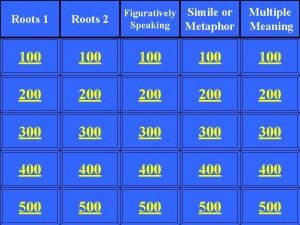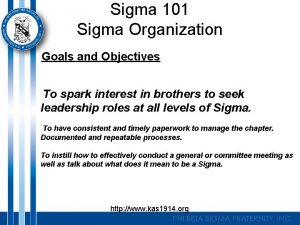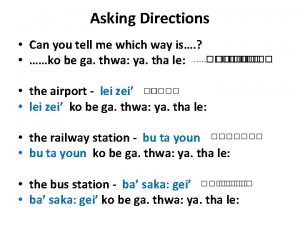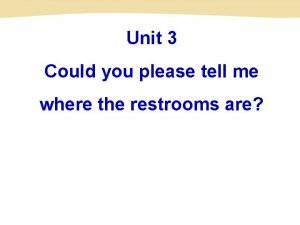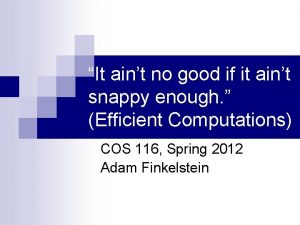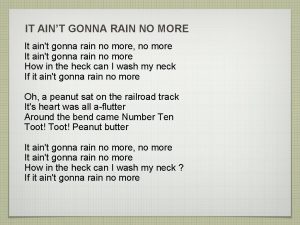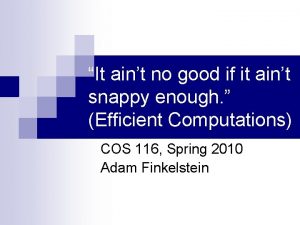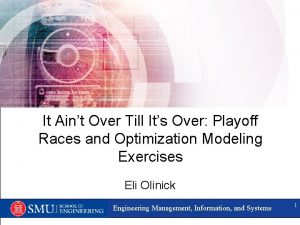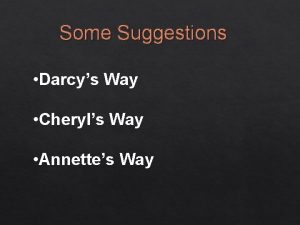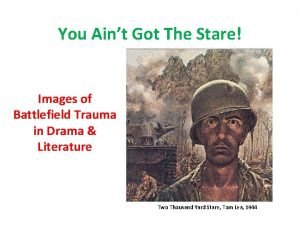IT AINT WHAT YOU DO ITS THE WAY

















































































- Slides: 81

IT AINT WHAT YOU DO IT’S THE WAY THAT YOU DO IT. USING BEHAVIOURAL ACTIVATION AS A PSYCHOLOGICAL INTERVENTION TO TREAT AND PREVENT DEPRESSION (IN THE THIRD AGE) Professor David Ekers Ph. D, MSc ENB 650, RMN

The talk What is BA/how does it work The evidence for BA to treat depression-a pragmatic choice Can it prevent depression (the CASPER study) Current ongoing studies

The intervention Behavioural Activation

Background to BA Skinner 1950’s introduces the operant conditioning. Observes depression associated with a break from established sources of positive reinforcement from environment Ferster 1973 -When stable sources of positive reinforcement lostdepression occurs-activity scheduling treatments introduced Showed promise in early randomised controlled trials Until the cognitive model took over in 1980 s External to the person Views depression as an understandable response in the context of client’s lives. Looks at depression as a consequence of person-environment interactions As such this relationship ‘person-environment’ is focus of the treatment

But may be somewhat older!

Robert Burton 1626 ‘I write of melancholy by being busy to avoid melancholy’ Connection between the mind and the body Emphasised the ‘creative blessings’ which come with melancholy Proposed activity, creativity and interaction with the natural world as a treatment

A reminder of Behavioural principles of reinforcement

Reinforcement Presented Positive Negative Omitted Positive Reinforcement Frustrative non reward Punishment Negative Reinforcement

Practical daily use of negative reinforcement

Behavioural activation cycle rationale (developed for our 2011 study

Behavioural activation (BA) Such as a physical health problem, retirement, bereavement etc.

Behavioural activation (BA) Life event leads to fewer behaviours that provide value and meaning in life

Behavioural activation (BA) …which leads the person to feel low

Behavioural activation (BA) Attempts to cope may include avoidance behaviours, which can maintain the problem

Behavioural activation (BA) Avoidance behaviours are negatively reinforced Reduction in positive reinforcement

Life event Became ill with diabetes and heart problems Secondary problems, friends stopping coming round Coping by avoidance: When friends called George didn’t feel up to going out so would make excuses. He stopped going to allotment even for short periods and hardly ever saw his friends Behavioural activation worked here to stop the cycle going round and worsening. Through step by step activity George gradually started to be more active towards his goals and broke the cycle. Isolation from valued activities: This led to not being able to do as much at the allotment and not going to football. George also had to reduce alcohol so didn't see friends as much Feeling Bad: Gradually George felt his confidence drop and he felt tired all the time. Some of this was illness and some low mood. He had no motivation to do any more than watch TV

BA Key Principles Relies on sound therapeutic alliance and collaborative relationship Focus on meaningful connection with the world ‘Outside-In’ rather than ‘Inside-Out’ approach � We don’t tell people to wait for some internal state to change before they can begin to change. � Change the outside and the inside will change � Rather than ‘waiting to feel better to do it’ – ‘do it to feel better’

R 2 D 2’s BA guide to treating depression Two Rs: Re-instate previous behaviours Replace old behaviours with new Two Ds: Disrupt unhelpful patterns of behaviour Decrease avoidance behaviours

Valued goals/not just any activity-need good targeting- Case examples scheduling for emotional goals

BA and depression

A long-long time ago Psychological Medicine 2008; 38(5): 611 -623.

Findings in 2008 BA vs. Control/Usual Care 12 studies (459 participants) Effect size -0. 70 in favour of BA (large) (95% CI − 0. 39 to − 1, p=0. 001), recovery rate favours BA OR= 4. 18 CI 1. 14 to 15. 28 (p=0. 03) BA vs. CT/CBT Twelve studies (476 patients) No difference effect size at post treatment and follow up (SMD 0. 08 95% CI − 0. 14 to 0. 30, SMD of 0. 25, 95% CI − 0. 21 to 0. 70, p=0. 28) or recovery rate (OR 0. 92, 95% CI 0. 59 to 1. 44, p=0. 72)


When you take out the dodgy ones


Evidence gap in 2008/9 All studies used highly qualified therapists Small studies of questionable quality NICE (2009) made a clear research recommendation “to establish whether behavioural activation is an effective alternative to CBT” using a study “large enough to determine the presence or absence of clinically important effects using a noninferiority design”

First step- test the feasibility of the idea of non specialist delivery

Results at follow up (3 months post randomisation n=47)

Economic Analysis Ekers D, Godfrey C, Gilbody S, Parrott S, Richards D, Hammond D and Hayes A. (In Press BJ Psych)

Cost more/less effective Cost less/less effective Cost more/more effective Cost less/more effective

Beware

Small Study - Big Limitations Small sample 2 therapists No follow up Strong signs of proof of principle and used as basis for COBRA and CASPER study applications

Open access- The Lancet July 2016

COBRA is a two-arm Phase III, non-inferiority randomised controlled trial of a psychological intervention: Behavioural Activation (BA) N=440. The COBRA programme of research sought to answer two interlinked questions: � What is the clinical effectiveness of BA (non specialist) compared to CBT for depressed adults in terms of depression treatment response measured by the PHQ 9 at six, 12 and 18 months? � What is the cost-effectiveness of BA compared to CBT at 18 months?

COBRA Hypotheses BA is non-inferior (1. 92 PHQ 9 points) to CBT (gold standard) for depressed adults in terms of depression treatment response at twelve and 18 months BA is more cost-effective than CBT at 18 months

What we found

CBT Baseline BA Adjusted A-B difference* P-value N Mean (SD) Mean (95% CI) 219 17. 4 (4. 8) 221 17. 7 (4. 8) - - 189 8. 4 (7. 5) 175 8. 4 (7. 0) 0. 1 (-1. 3 to 1. 5) 0. 89 151 7. 9 (7. 3) 135 7. 8 (6. 5) 0. 0 (-1. 5 to 1. 6) 0. 99 Intention to treat 12 -months Per protocol 12 -months *Adjusted for baseline PHQ 9, and stratification variables (i. e. , symptom severity (PHQ < 19, PHQ ≥ 19), site (Devon, Durham, Leeds), antidepressant use (currently taking anti-depressant medication, not currently taking antidepression medication)

Non inferiority margin Non-Inferiority at primary endpoint

Secondary Outcomes – What about anxiety (GAD-7) CBT N Baseline BA Mean (SD) 219 12. 6 (5. 1) Adjusted difference* P-value N Mean (SD) Mean (95% CI) 221 12. 7 (5. 1) - - 161 6. 4 (5. 9) 0. 1 (1. 3 to -1. 0) 0. 82 129 5. 9 (5. 5) 0. 01 (-1. 3 to 1. 2) 0. 95 Intention to treat 12 -months 176 6. 3 (6. 0) Per protocol 12 -months 146 6. 0 (5. 8) *Adjusted for baseline GAD, and stratification variables (i. e. , symptom severity (PHQ < 19, PHQ ≥ 19), site (Devon, Durham, Leeds), antidepressant use (currently taking antidepressant medication, not currently taking anti-depression medication)

ECONOMICS

Cost Effectiveness Plane Cost More/More Effective Cost More/Less Effective Difference in cost 6% £ 500 4% -. 05 0 . 05 . 15 -£ 1000 -£ 500 -. 1 £ 0 Difference in QALY 24% Cost Less/Less Effective £ 20 k/QALY threshold line 66% Cost Less/More Effective 95% confidence ellipse

Clinical Implications BA delivered by less experienced mental health workers leads to identical clinical outcomes for patients with depression, but at a financial saving to clinical providers of 21% compared with the costs of providing CBT. This is particularly relevant to the dissemination of effective psychological interventions for depression globally, particularly in low and medium income countries.

Using BA to prevent depression

Rationale-BA to Prevent Depression in over 65 s Can be delivered by non specialists Possibly a good public health message Makes sense to people


The CASPER trial Collaborative Care for Screen Positive Elders

CASPER Care for Screen Positive Elders

CASPER Care for Screen Positive Elders

CASPER Care for Screen Positive Elders

Who took part? 705 participants Over 65 s – mean age 77 (range 65 – 99 yrs) Whooley +ve with DSM-IV Subthreshold depression Very few exclusions � Recently bereaved � Alcohol dependence � Terminal illness � Cognitive impairment (ascertained by the GP) Comorbidity OK – 80% or more had 2+ LTCs

Collaborative care Case manage r Primary care physicia n Older adult Mental health speciali st Non-specialist Liaises with other health professionals Symptom monitoring Brief psychological treatment Over the phone Medication management

Functional equivalence Life events as we get older � � Physical health conditions Bereavement Retirement Change / loss of roles } These life events may make it difficult or impossible to reinstate previous behaviours Functional equivalence � � � Behaviours may look very different but serve the same function What function did the previous behaviour serve? Are there different behaviours that may serve the same function?

Design Recruitment from primary care Older adults with sub-threshold depression (N = 705) Collaborative care (with BA) (n = 344) Treatment as usual (N = 361) PHQ-9, GAD-7, PHQ-15, EQ-5 D, SF-12 (4 and 12 months)

er th 40% O n tio nd i co 11% e er an c 14% Ey C is rit th ar eo st is rit th ar 9% O d is os po r eo oi at um he R st es iti on nd co be t ia ro ke 20% O ry to ra pi es St e as se di 8% D rt ea re su es pr ol 6% H od bl o oh 50% R h ig Al c er 10% H ok Sm Physical health problems in CASPER 60% 48% 30% 30% 25% 21% 22% 17% 12% 0%

Outcomes @ 4 and 12 months PHQ 9 – continuous measure and ‘caseness’ for depressive disorder SF 12 GAD 7 PHQ 15 RISC 2

ar M 11 ay -1 Ju 1 l-1 Se 1 p. N 11 ov -1 Ja 1 n. M 12 ar M 12 ay -1 Ju 2 l-1 Se 2 p. N 12 ov -1 Ja 2 n. M 13 ar M 13 ay -1 Ju 3 l-1 3 M CASPER trial recruitment 800 700 600 500 400 200 100 0 target consented 300 actual consented

Primary outcome

PHQ 9 scores at 4 and 12 months

Does collaborative care prevent the onset of depression?

Did collaborative care prevent case level depression? Odds of case level depression were halved at 12 months OR = 1. 98 (1. 21 to 3. 25)

Did collaborative care prevent case level depression? Odds of case level depression were halved at 12 months OR = 1. 98 (1. 21 to 3. 25)

Is there a preventative element to CC? Odds of case level depression were halved at 12 months OR = 1. 98 (1. 21 to 3. 25)

What about secondary outcomes? SF 12 GAD 7 PHQ 15

SF 12 physical component score

SF 12 mental component score

GAD 7

PHQ 15 – somatoform complaints Symptoms for which the greatest improvements were observed were: Pain in arms, legs or joints; Dizziness; Shortness of breath; Constipation, loose bowels or diarrhoea; and Trouble sleeping.

What about antidepressants?

Some qualitative findings

BA and collaborative care Cos I suppose that the ideas are very kind of common sense but perhaps it’s this going through a more kind of formal process of like analysing what you do, how you feel, how they relate to each other and then sort of writing things down, I guess people say that’s helpful to …reflect and then think about what they might like to change…. . little things.

Functional equivalence But I think it was very good later on in the thing [booklet] where it said, ‘What could you do to replace, erm, you know, various activities if you had to stop doing them’. And I think that was good, to help you think round things

Using the phone Because I don’t like talking on the telephone all that much because of sort of interviews where you try and sort something out like your telephone or your inter, internet or something, and people talk too fast and too quickly and you feel terribly slow, but she wasn’t like that at all. She was very clear and patient … and it was fine, and relaxed and yeah. I thought it would be odd talking over a telephone about yourself, but it was alright.

Phone vs face to face Int: So would you have preferred having it face to face, all the sessions face to face? Q 11347 F: Well I think, yes I mean one would say that, but it wouldn’t matter. It’s, erm, …. it’s slightly self-indulgent having face to face [interactions] I think

And the cash!

Was it cost effective? Direct costs of collaborative care = £ 494 Some evidence of cost offset - £ 55 Worst case cost/QALY £ 9, 633 CC as delivered cost/QALY £ 3328

Was it cost effective?

Summary of findings Good engagement; liked the BA focus of the intervention and telephone management Moderate effect size 0. 3 Positive across a range of outcomes (signs in Physical and psychological functioning) Prevented the onset of case level depression (based on PHQ scores) Cost effective Largest UK trial of collaborative care to date Largest ever trial of CC for subthreshold depression

Our Current studies/collaborations Community Pharmacy Mood Intervention Study CHEMIST- Feasibility and Pilot study- Intervention adaption and Pilot RCT-results due early 2020. Good engagement and signs can deliver in innovative new settings- ave age 65 Multi-Morbidity in Older Adults (MODS)- 6 year program grant for applied research-adaption of BA to target functioning in over 65 s with 2 or more LTC inc depression. 3 or more LTC in people over 65 with sub threshold up to major depression-flexible BA design to target functioning

BA collaborations Impact BEACON study. Adaption of BA in South Asia settings with co morbid non Communicable disease. Insika Yomama. BA delivered by community workers in South Africa in perinatal depression with HIV+ status. Ba. NDep. BA for depression in Elderly care homes in Melbourne and Perth Depression prevention in older adults in Brazil using BA focused targeted health promotion audio messages. Audio whats app!-Sao Paulo-BA advice and case stories via audio message-story arc over 4 themes and upp to 48 1 minute messages.

Summary BA is a practical treatment aiming to re engage people with positive reinforcement from their environment. Evidence in adults-older adults suggest it works well Evidence in younger people is limited and probably requires a large scale RCT Current research is testing BA in a range of new settings

Acknowledgements thanks for listening Too many to mention Team-CASPER/COBRA and beyond study participants More info david. ekers@nhs. net Twitter @David. Ekers Disclaimer for COBRA and CASPER studies n These project was funded by the NIHR Health Technology Assessment programme. n The views and opinions expressed therein are those of the authors and do not necessarily reflect those of the HTA programme, NIHR, NHS or the Department of Health.
 Aint no black in the union jack
Aint no black in the union jack One way table and two way table
One way table and two way table Two way anova
Two way anova Difference between binary tree and threaded binary tree
Difference between binary tree and threaded binary tree Perbedaan one way dan two way anova
Perbedaan one way dan two way anova What does one way anova tell you
What does one way anova tell you One way anova vs two way anova
One way anova vs two way anova Analiza anova
Analiza anova Conventional software engineering
Conventional software engineering This way that way over the irish sea
This way that way over the irish sea Walk this way talk this way
Walk this way talk this way معنیroots
معنیroots The way a mineral reflects light from its surface
The way a mineral reflects light from its surface Phi beta sigma our cause speeds on its way lyrics
Phi beta sigma our cause speeds on its way lyrics Lesson 1 a new global conflict
Lesson 1 a new global conflict Structure of emigree
Structure of emigree When a train increases its velocity its momentum
When a train increases its velocity its momentum Weather sunny cloudy rainy windy
Weather sunny cloudy rainy windy If its a square it's a sonnet summary
If its a square it's a sonnet summary Its halloween its halloween the moon is full and bright
Its halloween its halloween the moon is full and bright Its not easy but its worth it
Its not easy but its worth it Hát kết hợp bộ gõ cơ thể
Hát kết hợp bộ gõ cơ thể Ng-html
Ng-html Bổ thể
Bổ thể Tỉ lệ cơ thể trẻ em
Tỉ lệ cơ thể trẻ em Chó sói
Chó sói Tư thế worm breton
Tư thế worm breton Chúa yêu trần thế
Chúa yêu trần thế Các môn thể thao bắt đầu bằng tiếng nhảy
Các môn thể thao bắt đầu bằng tiếng nhảy Thế nào là hệ số cao nhất
Thế nào là hệ số cao nhất Các châu lục và đại dương trên thế giới
Các châu lục và đại dương trên thế giới Công thức tính thế năng
Công thức tính thế năng Trời xanh đây là của chúng ta thể thơ
Trời xanh đây là của chúng ta thể thơ Mật thư tọa độ 5x5
Mật thư tọa độ 5x5 Làm thế nào để 102-1=99
Làm thế nào để 102-1=99 độ dài liên kết
độ dài liên kết Các châu lục và đại dương trên thế giới
Các châu lục và đại dương trên thế giới Thơ thất ngôn tứ tuyệt đường luật
Thơ thất ngôn tứ tuyệt đường luật Quá trình desamine hóa có thể tạo ra
Quá trình desamine hóa có thể tạo ra Một số thể thơ truyền thống
Một số thể thơ truyền thống Cái miệng xinh xinh thế chỉ nói điều hay thôi
Cái miệng xinh xinh thế chỉ nói điều hay thôi Vẽ hình chiếu vuông góc của vật thể sau
Vẽ hình chiếu vuông góc của vật thể sau Biện pháp chống mỏi cơ
Biện pháp chống mỏi cơ đặc điểm cơ thể của người tối cổ
đặc điểm cơ thể của người tối cổ Ví dụ về giọng cùng tên
Ví dụ về giọng cùng tên Vẽ hình chiếu đứng bằng cạnh của vật thể
Vẽ hình chiếu đứng bằng cạnh của vật thể Fecboak
Fecboak Thẻ vin
Thẻ vin đại từ thay thế
đại từ thay thế điện thế nghỉ
điện thế nghỉ Tư thế ngồi viết
Tư thế ngồi viết Diễn thế sinh thái là
Diễn thế sinh thái là Dạng đột biến một nhiễm là
Dạng đột biến một nhiễm là Bảng số nguyên tố
Bảng số nguyên tố Tư thế ngồi viết
Tư thế ngồi viết Lời thề hippocrates
Lời thề hippocrates Thiếu nhi thế giới liên hoan
Thiếu nhi thế giới liên hoan ưu thế lai là gì
ưu thế lai là gì Sự nuôi và dạy con của hươu
Sự nuôi và dạy con của hươu Khi nào hổ mẹ dạy hổ con săn mồi
Khi nào hổ mẹ dạy hổ con săn mồi Sơ đồ cơ thể người
Sơ đồ cơ thể người Từ ngữ thể hiện lòng nhân hậu
Từ ngữ thể hiện lòng nhân hậu Thế nào là mạng điện lắp đặt kiểu nổi
Thế nào là mạng điện lắp đặt kiểu nổi You say you love the rain but you open your umbrella
You say you love the rain but you open your umbrella Agree or disagree questions about life
Agree or disagree questions about life If you think you can you can poem
If you think you can you can poem Tell me what you eat and i shall tell you what you are
Tell me what you eat and i shall tell you what you are Wherever you lead i will follow
Wherever you lead i will follow Stir you up by way of reminder
Stir you up by way of reminder The way you view situations
The way you view situations Contoh persepsi kontekstual
Contoh persepsi kontekstual If you encounter a vehicle headed the wrong way
If you encounter a vehicle headed the wrong way Chresteuomai
Chresteuomai Restoring lost body fluids
Restoring lost body fluids You have not passed this way before
You have not passed this way before What do you think of the way atticus treats walter
What do you think of the way atticus treats walter Which way do you
Which way do you Treat others the way you would like to be treated
Treat others the way you would like to be treated Excuse me could you tell me the way to the national museum
Excuse me could you tell me the way to the national museum Asking the way and giving directions
Asking the way and giving directions It's amazing how you can speak
It's amazing how you can speak It's monday you know what that means
It's monday you know what that means











